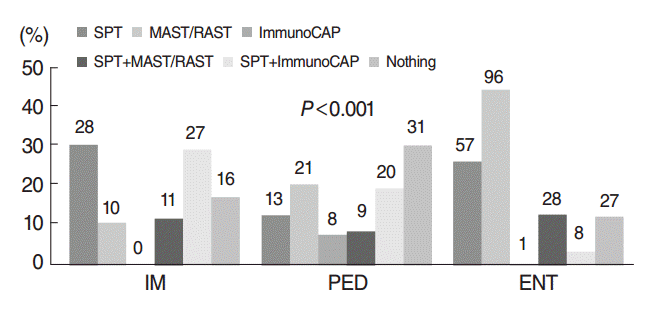1. Ahn JC, Kim JW, Lee CH, Rhee CS. Prevalence and risk factors of chronic rhinosinusitus, allergic rhinitis, and nasal septal deviation: results of the Korean National Health and Nutrition Survey 2008-2012. JAMA Otolaryngol Head Neck Surg. 2016; Feb. 142(2):162–7.
2. Cho YS, Choi SH, Park KH, Park HJ, Kim JW, Moon IJ, et al. Prevalence of otolaryngologic diseases in South Korea: data from the Korea national health and nutrition examination survey 2008. Clin Exp Otorhinolaryngol. 2010; Dec. 3(4):183–93.

3. Yoo KH, Ahn HR, Park JK, Kim JW, Nam GH, Hong SK, et al. Burden of respiratory disease in Korea: an observational study on allergic rhinitis, asthma, COPD, and rhinosinusitis. Allergy Asthma Immunol Res. 2016; Nov. 8(6):527–34.

4. Bousquet J, Khaltaev N, Cruz AA, Denburg J, Fokkens WJ, Togias A, et al. Allergic Rhinitis and its Impact on Asthma (ARIA) 2008 update (in collaboration with the World Health Organization, GA(2)LEN and AllerGen). Allergy. 2008; Apr. 63 Suppl 86:8–160.
5. Seidman MD, Gurgel RK, Lin SY, Schwartz SR, Baroody FM, Bonner JR, et al. Clinical practice guideline: allergic rhinitis. Otolaryngol Head Neck Surg. 2015; Feb. 152(1 Suppl):S1–43.
6. Korean Rhinologic Society. Guidelines for allergic rhinitis. Seoul: Korean Rhinologic Society;2012.
7. Korean Academy of Asthma, Allergy and Clinical Immunology. Guidelines for clinicians: allergic rhinitis. Seoul: Korean Academy of Asthma, Allergy and Clinical Immunology;2015.
8. Hur GY, Kim TB, Han MY, Nahm DH, Park JW, Immunotherapy Work Group of the Korean Academy of Asthma, Clinical Immunology (KAAACI). A survey of the prescription patterns of allergen immunotherapy in Korea. Allergy Asthma Immunol Res. 2013; Sep. 5(5):277–82.

9. Dhong HJ. Classification of allergic rhinitis: what is most suitable in Korea. Allergy Asthma Immunol Res. 2013; Mar. 5(2):65–7.

10. Rhee CS. Current specific immunotherapy for allergic rhinitis: perspectives from otorhinolaryngologists. Allergy Asthma Immunol Res. 2014; Jul. 6(4):273–5.

11. Jung YG, Cho HJ, Park GY, Min JY, Kim HY, Dhong HJ, et al. Comparison of the skin-prick test and Phadia ImmunoCAP as tools to diagnose house-dust mite allergy. Am J Rhinol Allergy. 2010; May-Jun. 24(3):226–9.

12. Bousquet J, Chanez P, Chanal I, Michel FB. Comparison between RAST and Pharmacia CAP system: a new automated specific IgE assay. J Allergy Clin Immunol. 1990; Jun. 85(6):1039–43.

13. Scolozzi R, Vicentini L, Boccafogli A, Camerani A, Pradella R, Cavallini A, et al. Comparative evaluation of RAST and MAST-CLA for six allergens for the diagnosis of inhalant allergic disease in 232 patients. Clin Exp Allergy. 1992; Feb. 22(2):227–31.

14. Brozek JL, Bousquet J, Baena-Cagnani CE, Bonini S, Canonica GW, Casale TB, et al. Allergic Rhinitis and its Impact on Asthma (ARIA) guidelines: 2010 revision. J Allergy Clin Immunol. 2010; Sep. 126(3):466–76.
15. Wheatley LM, Togias A. Clinical practice: allergic rhinitis. N Engl J Med. 2015; Jan. 372(5):456–63.
16. Zhou H, Tao QL, Wei JM, Xu G, Cheng L. Trends in specific immunotherapy for allergic rhinitis: a survey of chinese ENT specialists. Allergy Asthma Immunol Res. 2014; Jul. 6(4):296–303.

17. Lin Z, Liu Q, Li T, Chen D, Chen D, Xu R. The effects of house dust mite sublingual immunotherapy in patients with allergic rhinitis according to duration. Int Forum Allergy Rhinol. 2016; Jan. 6(1):82–7.

18. Cingi C, Bayar Muluk N, Ulusoy S, Acar M, Sirin S, Cobanoglu B, et al. Efficacy of sublingual immunotherapy for house dust mite allergic rhinitis. Eur Arch Otorhinolaryngol. 2015; Nov. 272(11):3341–6.

19. Cardona V, Luengo O, Labrador-Horrillo M. Immunotherapy in allergic rhinitis and lower airway outcomes. Allergy. 2017; Jan. 72(1):35–42.

20. Kim SH, Mun SJ, Han DH, Kim JW, Kim DY, Rhee CS. Three-year follow-up results of sublingual immunotherapy in patients with allergic rhinitis sensitized to house dust mites. Allergy Asthma Immunol Res. 2015; Mar. 7(2):118–23.

21. Marogna M, Spadolini I, Massolo A, Canonica GW, Passalacqua G. Long-lasting effects of sublingual immunotherapy according to its duration: a 15-year prospective study. J Allergy Clin Immunol. 2010; Nov. 126(5):969–75.
22. Dretzke J, Meadows A, Novielli N, Huissoon A, Fry-Smith A, Meads C. Subcutaneous and sublingual immunotherapy for seasonal allergic rhinitis: a systematic review and indirect comparison. J Allergy Clin Immunol. 2013; May. 131(5):1361–6.
23. Varney VA, Tabbah K, Mavroleon G, Frew AJ. Usefulness of specific immunotherapy in patients with severe perennial allergic rhinitis induced by house dust mite: a double-blind, randomized, placebo-controlled trial. Clin Exp Allergy. 2003; Aug. 33(8):1076–82.

24. Jacobsen L, Niggemann B, Dreborg S, Ferdousi HA, Halken S, Host A, et al. Specific immunotherapy has long-term preventive effect of seasonal and perennial asthma: 10-year follow-up on the PAT study. Allergy. 2007; Aug. 62(8):943–8.

25. Kim TB, Kim KM, Kim SH, Kang HR, Chang YS, Kim CW, et al. Sensitization rates for inhalant allergens in Korea; a multi-center study. J Asthma Allergy Clin Immunol. 2003; Sep. 23(3):483–93.
26. Calderon MA, Cox LS. Monoallergen sublingual immunotherapy versus multiallergen subcutaneous immunotherapy for allergic respiratory diseases: a debate during the AAAAI 2013 Annual Meeting in San Antonio, Texas. J Allergy Clin Immunol Pract. 2014; Mar-Apr. 2(2):136–43.

27. Amar SM, Harbeck RJ, Sills M, Silveira LJ, O’Brien H, Nelson HS. Response to sublingual immunotherapy with grass pollen extract: monotherapy versus combination in a multiallergen extract. J Allergy Clin Immunol. 2009; Jul. 124(1):150–6. e1-5.

28. Nelson HS. Multiallergen immunotherapy for allergic rhinitis and asthma. J Allergy Clin Immunol. 2009; Apr. 123(4):763–9.






 PDF
PDF Citation
Citation Print
Print


 XML Download
XML Download